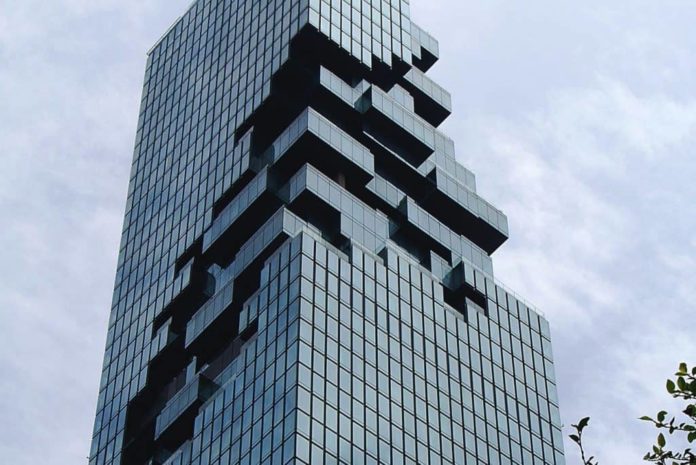(Bloomberg) — More than 130 years ago, the Orient Express redefined luxury train travel, leaving an indelible mark on popular culture. Although the rail line has taken its farewell journey, a new line of hotels is ensuring that you can still enjoy the opulence of legendary carriages, without the risk of motion sickness.
Accor, doing business as AccorHotels, is relaunching a slate of hotels with the Orient Express name. The first will open in Bangkok next summer, with 10 total properties by 2030.
Read also: Explore 10,000 Years of Luxury at Louvre Abu Dhabi next October
“If we succeed by sharing the history, guests will feel like they are part of the myth of the Orient Express,” says Guillaume de Saint Lager, executive director of the Orient Express Hotels.
The Bangkok Orient Express hotel will be located in the 78-story King Power Mahanakhon skyscraper, renowned for its pixelated, Lego-like facade. The second-tallest building in the city is also home to the Ritz-Carlton Residence.
Although the Orient Express never traveled to Bangkok, interior designer Tristan Auer seeks to bring its historic aura to the new location by combining Thai and French artistic styles. The hotel will have 154 rooms, a rooftop pool with views over the bustling city, two restaurants, a spa, and two bars.
What’s in a Name?
This is not the first time the Orient Express name has been used for luxury lodging. And the history is as twisted as an Agatha Christie tale.
France’s government rail group SNCF has owned the Orient Express brand name since the 1970s. It previously allowed U.K. hotel group Orient-Express Hotels, established in 1976, to use the name for its portfolio of 45 luxury hotels, along with six luxury trains, three river cruises, and a restaurant.
In 2014, Orient-Express Hotels announced that it would rebrand its holdings as Belmond Ltd., derived from the Latin word for beautiful, and is now part of LVMH. On terminating its licensing agreement, Ralph Aruzza, Orient-Express Hotels’ chief sales and marketing officer, said at the time that the change occurred in part because consumers identified the Orient Express name with the iconic train and not the brand’s multifaceted portfolio.
Then, in 2017, AccorHotels acquired a 50% stake in the Orient Express name, and SNCF indicated it would develop its own line of hotels under the moniker.
A Rich History
Much more than the previous Belmond properties, which were luxurious but stopped short of a connecting theme, AccorHotels is trying to capitalize on the mythical quality of the name by infusing stories of the original train into its new chain. The company hired historian Arthur Mettetal to be its brand heritage manager.
“The train is the expression of luxury as applied to a vehicle,” he says. “More than just a train, it has become a cultural object and a source of inspiration for literature and cinema.”
The Orient Express embarked on its maiden passage in 1883, covering the 3,959 miles between Paris and Constantinople in 13 days. Some of its prime came during the art deco period of the 1920s, when new Pullman lounge cars were introduced, with designs by glassmaker René Lalique and decorator René Prou.
Destinations included Munich, Budapest, and Constantinople (now Istanbul), explains author and historian Arjan den Boer, who has written about the Orient Express. “It has to do with the exotic destinations,” he says of the train’s fame. “With the luxury, it was out of reach for most people.”
Then, of course, there’s the well-known book, Murder on the Orient Express by Agatha Christie, published in 1934 and most recently made for a second time as a movie directed by and starring Kenneth Branagh with a who’s whodunit of a cast, including Penélope Cruz, Judi Dench, Willem Dafoe, Johnny Depp, and Michelle Pfeiffer.
“The Agatha Christie book has given it a romanticism, but I think she chose that because it was already quite famous and full of intrigue,” says railway historian and journalist Christian Wolmar. “It always had a sense of adventure about traveling on it. Before the airlines arrived, it was the way to get to Turkey.”
Coaches in the Orient Express offered the most luxurious features of the time, such as intricate wood paneling, leather armchairs, and silk sheets. The meal services, which could be up to eight courses, were top-notch as well, featuring crystal decanters, fresh white tablecloths, and glittering glasses.
“You meet all kinds of people on the train. By car is more private, and plane is more quick,” Den Boer says. “You dine together, you pass all kinds of countries. It’s relaxing and exciting.”
A Train in a Hotel
Auer, the Bangkok hotel’s interior designer, used these historic sleeper trains as his inspiration, incorporating features such as oval windows with stained glass and leather paneling. Decorations with lacquer, silk, ceramics, and basketwork in the lobby will echo the trimmings and cabinet work in individual rooms.
“I was most excited about the design of the bathroom,” Auer notes. “The details are endless, from the swivel mirrors to the lacquer panels made in Thailand.”
For the guest rooms, he installed custom banquettes and leather headboards with small pockets to store items such as phones, books, and glasses, and showcased old photographs on the walls, with a book about the train’s history in each room. Auer gave the public a preview of the design this month at the annual AD Intérieurs show in Paris organized by France’s Architectural Digest magazine.
He displayed a recreation of the upcoming Bangkok hotel’s bar, to be called Wagon-Bar, with a marquetry edged counter framed by shelves of Champagne bottles and woven-bulrush lanterns to be featured in all future Orient Express hotels. The lettering of the bar’s name is the same as that on the outside of the original train cars.
De Saint Lager notes that hotels will be placed in sites in Europe, North America, Asia, and the Middle East and will combine the overall Orient Express theme with destination-specific touches. For instance, individual decorations may reflect the characteristics of a given city, but the uniforms of hotel staff (called “conductors”) and the music will be standardized.
“It’s difficult because everybody has a different idea of the Orient Express,” De Saint Lager says of living up to the public’s imagination of the grandeur. “We have to refer to the history and never break the link. That’s where we get the authenticity of what we do.”






